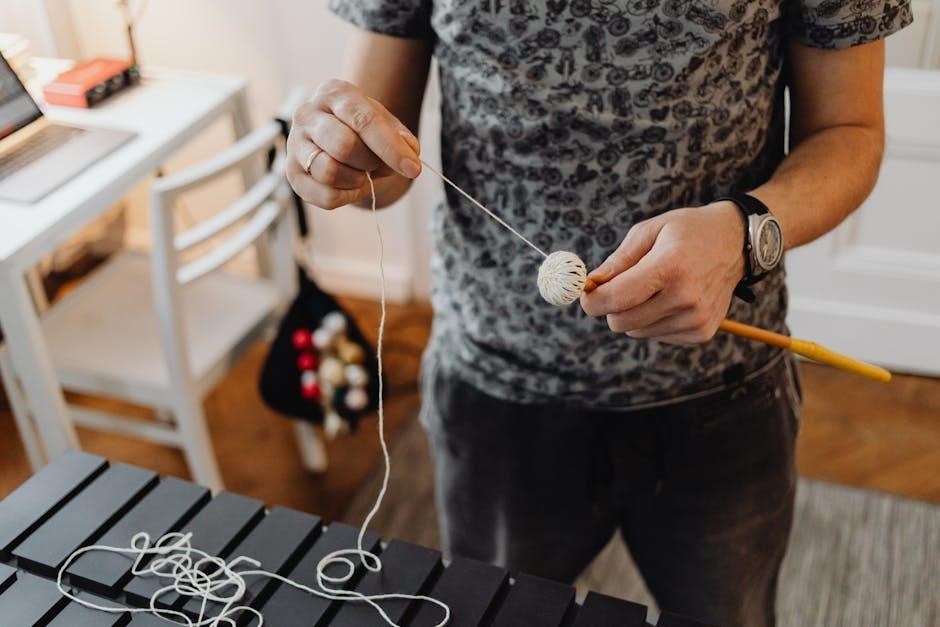Manual winding watches require daily winding‚ using a crown to tighten the mainspring‚ providing power to the timepiece‚ with a traditional mechanism‚ found in many classic watches‚ with a unique charm and character always.
Definition of Manual Winding Watch
A manual winding watch is a type of timepiece that requires the wearer to wind it up by hand on a regular basis‚ typically daily‚ to keep it functioning. This is achieved by turning the crown‚ which tightens the mainspring‚ providing power to the watch. The manual winding mechanism is a traditional and classic way of powering a watch‚ and it is often found in high-end and luxury timepieces. According to the information available‚ a manual winding watch is also sometimes referred to as a hand-wound watch‚ and it is characterized by its need for regular winding to keep it accurate and functional. The definition of a manual winding watch is closely tied to its mechanical movement‚ which is designed to be wound by hand‚ rather than automatically‚ like some other types of watches. Overall‚ a manual winding watch is a unique and charming timepiece that requires attention and care from its wearer. The watch’s mechanism is designed to be durable and long-lasting‚ with proper care and maintenance.

History of Manual Winding Watches
Manual winding watches originated in the early days of watchmaking‚ with historic records showing their development and evolution over time slowly and carefully always.
Evolution of Watch Design
The evolution of watch design has been a gradual process‚ with manual winding watches undergoing significant changes over the years.
The introduction of new materials and technologies has enabled watchmakers to create more intricate and complex designs‚
while still maintaining the traditional charm of manual winding watches.
The use of precious metals‚ such as gold and silver‚ has become more widespread‚
and the incorporation of delicate engravings and ornate details has added to the aesthetic appeal of these timepieces.
Furthermore‚ the development of more efficient winding mechanisms has improved the overall functionality of manual winding watches‚
making them more reliable and accurate.
As a result‚ manual winding watches have become highly sought after by collectors and connoisseurs‚
who appreciate their unique blend of traditional craftsmanship and modern innovation‚
and the way they have evolved over time to become the sophisticated timepieces we see today‚ with a rich history.

Comparison with Automatic Watches
Manual winding watches differ from automatic watches in their winding mechanism‚ requiring manual intervention always daily.
Differences in Winding Mechanism
The primary difference between manual winding and automatic watches lies in their winding mechanism‚ with manual winding watches requiring daily winding using a crown to tighten the mainspring‚ providing power to the timepiece.
In contrast‚ automatic watches utilize a rotor to wind the mainspring‚ eliminating the need for manual winding‚ and instead‚ harnessing the wearer’s movements to generate power.
This fundamental difference in winding mechanism significantly impacts the overall design‚ functionality‚ and user experience of the two types of watches‚ with manual winding watches often being prized for their traditional craftsmanship and nostalgic appeal.
Furthermore‚ the winding mechanism of manual winding watches allows for a more intimate connection between the wearer and the timepiece‚ as the daily ritual of winding becomes a meaningful interaction with the watch‚ fostering a sense of ownership and appreciation.
Ultimately‚ the differences in winding mechanism between manual winding and automatic watches cater to distinct preferences and needs‚ making each type of watch unique and desirable in its own right‚ with their own set of characteristics and advantages.

Key Components of Mechanical Watches
Mechanical watches consist of gears‚ mainspring‚ and escapement‚ working together to measure time‚ with intricate mechanisms and precise engineering‚ forming a complex system‚ always requiring maintenance and care carefully.
Understanding the Basics
To comprehend the intricacies of manual winding watches‚ it is essential to understand the fundamental principles of mechanical timepieces. The core components of a mechanical watch include the mainspring‚ gears‚ and escapement‚ which work in harmony to measure time. The mainspring stores energy‚ which is then transmitted to the gears‚ ultimately powering the watch’s hands. The escapement regulates the release of this energy‚ ensuring a consistent and accurate timekeeping. By grasping these basic concepts‚ one can appreciate the craftsmanship and engineering that goes into creating a manual winding watch. Furthermore‚ understanding the basics of mechanical watches provides a solid foundation for exploring the nuances of manual winding timepieces‚ including their history‚ design‚ and functionality. With this knowledge‚ enthusiasts can better appreciate the unique characteristics and charm of manual winding watches‚ and make informed decisions when selecting a timepiece that suits their needs and preferences.

Practical Considerations
Manual winding watches require regular winding‚ affecting daily routines‚ with owners needing to wind them to maintain accuracy and functionality always and consistently every day with careful attention.
Convenience and Craftsmanship
Manual winding watches offer a unique blend of convenience and craftsmanship‚ with many owners appreciating the traditional mechanism and the attention to detail that comes with it. The process of winding a watch can be a meditative experience‚ allowing the owner to connect with the timepiece on a deeper level. Additionally‚ manual winding watches often feature intricate designs and beautiful craftsmanship‚ making them a joy to wear and own. The convenience of not having to worry about battery replacement is also a significant advantage‚ as manual winding watches can run for decades with proper maintenance. Furthermore‚ the craftsmanship that goes into creating a manual winding watch is often exceptional‚ with many watches featuring intricate details and beautiful finishes. Overall‚ manual winding watches offer a unique combination of convenience‚ craftsmanship‚ and traditional watchmaking techniques. They are a testament to the skill and expertise of watchmakers and a reminder of the beauty of mechanical timepieces.